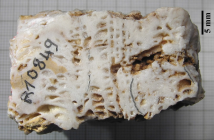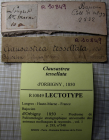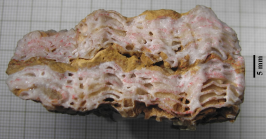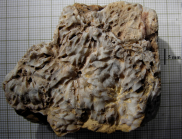Scleractinia taxon details
Clausastrea d'Orbigny, 1849 †
1438143 (urn:lsid:marinespecies.org:taxname:1438143)
accepted
Genus
Clausastrea tessellata d'Orbigny, 1849 † (type by monotypy)
Clausastraea d'Orbigny, 1849 † · unaccepted > misspelling - incorrect subsequent spelling
Meandramorpha Babaev, 1973 † · unaccepted > junior subjective synonym
Meandromorpha Babaev, 1973 † · unaccepted > misspelling - incorrect subsequent spelling
- Species Clausastrea affinis Alloiteau, 1960 †
- Species Clausastrea alloiteaui Morycowa, 1964 †
- Species Clausastrea bohemoslovaco (Eliášová, 1976) †
- Species Clausastrea calloviensis (Koby, 1887) †
- Species Clausastrea confluens (Quenstedt, 1852) †
- Species Clausastrea eliasovae Ricci, Lathuilière & Rusciadelli, 2018 †
- Species Clausastrea julistephanovi Zlatarski, 1967 †
- Species Clausastrea magna Reig Oriol, 1997 †
- Species Clausastrea parva Milne Edwards & Haime, 1857 †
- Species Clausastrea pseudoconfluens Eliášová, 1976 †
- Species Clausastrea querolensis Alloiteau, 1960 †
- Species Clausastrea superficialis Alloiteau, 1960 †
- Species Clausastrea tessellata d'Orbigny, 1849 †
- Species Clausastrea topalensis Roniewicz, 1976 †
- Species Clausastrea consobrina Milne Edwards & Haime, 1851 † accepted as Isastrea consobrina (Milne Edwards & Haime, 1851) † (basionym, changed combination)
marine, fresh, terrestrial
fossil only
Orbigny, A. D. d'. (1849). Note sur des Polypiers fossiles. <em>Revue et Magasin de Zoologie, 2e sér.</em> 1: 526-538. [details]
Description Colonial massive subthamnasterioid to submeandroid according to species. Radial elements are subconfluent to confluent...
Status Edwards and Haime 1849c never created a new genus Clausastrea but they assigned their Quaternary new species C. savignyi ...
Description Colonial massive subthamnasterioid to submeandroid according to species. Radial elements are subconfluent to confluent according to species. No holotheca, no wall. Radial elements are compact costosepta or biseptal sheets of Montlivaltid structure. Rarely anastomosed Intracalicular increase dominant. Well developed endotheca made of tabulae and very large dissepiments producing a characteristic wavy pattern in longitudinal section. Deep parts of the endotheca in the axial zones of corallites. No synapticule, no columella. [details]
Status Edwards and Haime 1849c never created a new genus Clausastrea but they assigned their Quaternary new species C. savignyi ...
Status Edwards and Haime 1849c never created a new genus Clausastrea but they assigned their Quaternary new species C. savignyi and the Tertiary species Astrea tessellata Michelin to the genus previously created by d'Orbigny during the same year. Two years later, they assigned both species to Plerastrea (p. 107). Today they are considered as Favites (see this genus) [details]
Hoeksema, B. W.; Cairns, S. (2024). World List of Scleractinia. Clausastrea d'Orbigny, 1849 †. Accessed at: https://www.marinespecies.org/scleractinia/aphia.php?p=taxdetails&id=1438143 on 2024-05-02
original description
Orbigny, A. D. d'. (1849). Note sur des Polypiers fossiles. <em>Revue et Magasin de Zoologie, 2e sér.</em> 1: 526-538. [details]
additional source Alloiteau J. (1960). Sur le genre Clausastrea. <em>Annales de Paléontologie (Invertébrés).</em> 46: 3-46. [details]
additional source Alloiteau J. (1960). Sur le genre Clausastrea. <em>Annales de Paléontologie (Invertébrés).</em> 46: 3-46. [details]
 Present
Present  Inaccurate
Inaccurate  Introduced: alien
Introduced: alien  Containing type locality
Containing type locality
From editor or global species database
Description Colonial massive subthamnasterioid to submeandroid according to species. Radial elements are subconfluent to confluent according to species. No holotheca, no wall. Radial elements are compact costosepta or biseptal sheets of Montlivaltid structure. Rarely anastomosed Intracalicular increase dominant. Well developed endotheca made of tabulae and very large dissepiments producing a characteristic wavy pattern in longitudinal section. Deep parts of the endotheca in the axial zones of corallites. No synapticule, no columella. [details]Remark 20 nominal species known in Jurasssic and 13 in Cretaceous (Löser 2000). Probably polyphyletic. [details]
Status Edwards and Haime 1849c never created a new genus Clausastrea but they assigned their Quaternary new species C. savignyi and the Tertiary species Astrea tessellata Michelin to the genus previously created by d'Orbigny during the same year. Two years later, they assigned both species to Plerastrea (p. 107). Today they are considered as Favites (see this genus) [details]



